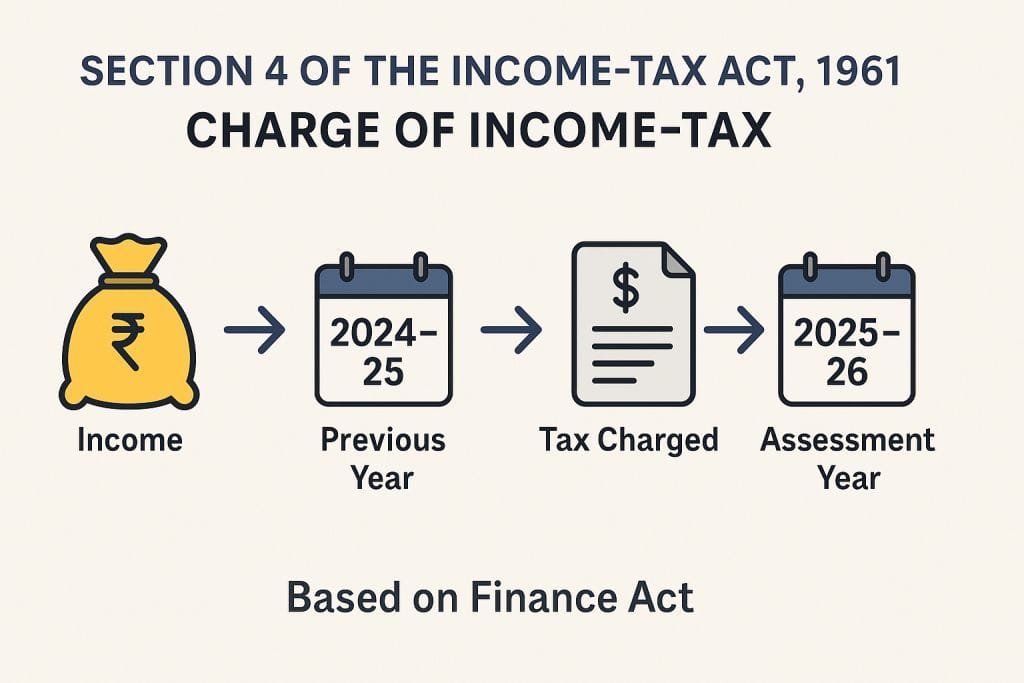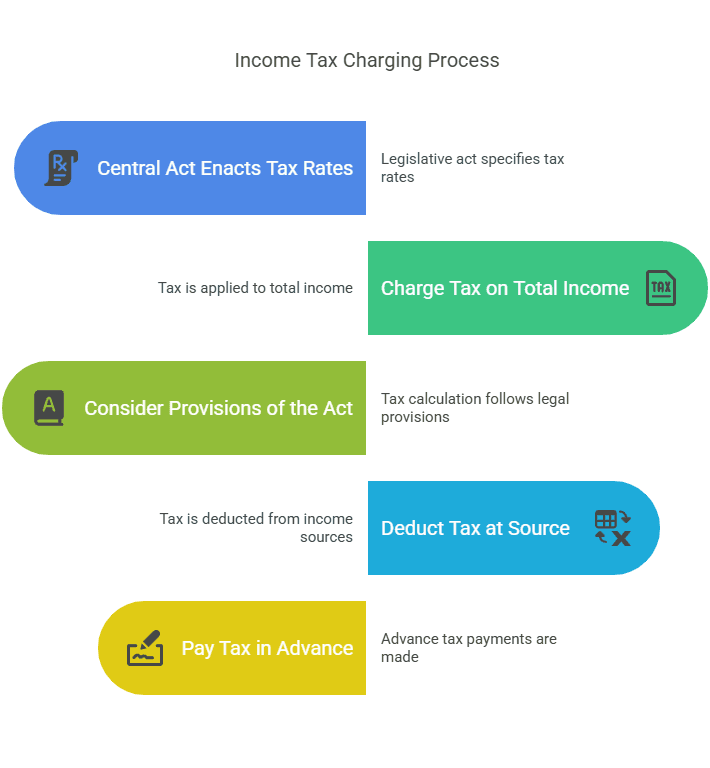Section 4 of Income Tax Act 1961 – Charge of income-tax
Section 4(1) of Income Tax Act 1961
Where any Central Act enacts that income-tax shall be charged for any assessment year at any rate or rates, income-tax at that rate or those rates shall be charged for that year in accordance with, and subject to the provisions (including provisions for the levy of additional income-tax) of, this Act in respect of the total income of the previous year of every person :
Provided that where by virtue of any provision of this Act income-tax is to be charged in respect of the income of a period other than the previous year, income-tax shall be charged accordingly.
Section 4(2) of Income Tax Act 1961
In respect of income chargeable under sub-section (1), income-tax shall be deducted at the source or paid in advance, where it is so deductible or payable under any provision of this Act.
Explanation of Section 4 of Income Tax Act 1961
📘 Section 4 of the Income Tax Act, 1961 – “Charge of Income-Tax”
🔍 What is Section 4?
Section 4 is the charging section of the Income-tax Act.
It gives the government the legal authority to levy income tax on income earned in a previous year.
🧾 Key Provisions of Section 4
- Income-tax is charged on every person (individuals, HUFs, companies, firms, etc.)
- Tax is levied on total income earned during the previous year.
- It is charged at the rates prescribed by the Finance Act of the relevant year.
- Tax is collected in the Assessment Year following the Previous Year.
📅 Example:
Let’s say:
- You earn ₹10,00,000 between 1st April 2024 to 31st March 2025 (Previous Year).
- Tax on this amount will be charged and collected in AY 2025–26, as per the rates in the Finance Act, 2025.
💡 Simple Breakdown:
| Concept | Meaning |
|---|---|
| Section 4 | Gives legal power to collect tax on income |
| Who pays tax? | Every person earning taxable income |
| Tax is based on | Income earned in the Previous Year |
| Tax collected in | The Assessment Year, at Finance Act rates |
🧠 Real-Life Example:
- Ms. Kavya is a salaried employee.
- She earns ₹12,00,000 from April 2024 to March 2025.
- As per Section 4:
- This income is taxable.
- Tax will be charged in AY 2025–26, based on that year’s Finance Act.
Infographic that visually explains Section 4 with the key flow:
“Income → Previous Year → Tax Charged → Assessment Year → Based on Finance Act”.
Here we go:


🔁 Special Points to Remember
🔹 1. Legal Authority
Section 4 empowers the government to collect income tax.
Without this section, no income tax can legally be levied.
🔹 2. Who is Taxed?
Every “person” is liable to pay tax if their income exceeds the basic exemption limit.
This includes:
- Individuals
- Hindu Undivided Families (HUFs)
- Firms
- Companies
- Associations of Persons (AOPs), etc.
🔹 3. Finance Act is Key
The Finance Act, passed every year with the Union Budget, prescribes the rates of tax applicable for that Assessment Year.
So, even though Section 4 gives the authority to charge tax, the actual rates come from the Finance Act.
📊 Section 3 vs Section 4 – Comparison Chart
| Feature | Section 3 | Section 4 |
|---|---|---|
| Focus | Defines the Previous Year | Grants power to charge income tax |
| Applies To | All taxpayers | All persons earning taxable income |
| Key Concept | Period in which income is earned | Year in which income is charged to tax |
| Time Frame | Always from 1st April to 31st March | Income taxed in Assessment Year (next FY) |
| Taxability | No tax is levied here – just defines the year | Tax is levied as per Finance Act |
| Connection with Finance Act | Not dependent on Finance Act | Tax rates are taken from the Finance Act |
✅ Key Takeaways: Section 4
- Section 4 is the backbone of income-tax collection in India.
- It gives the legal authority to charge tax on the total income of every taxpayer.
- Tax is not charged randomly — it’s charged:
- On income earned in the Previous Year
- In the Assessment Year
- At rates declared in the Finance Act
- Everyone — whether an individual, business, or company — comes under this provision if their income is taxable.
📋 Final Revision Summary – Section 4 of Income Tax Act, 1961
- 📌 Purpose: Charging section – allows income tax to be levied.
- 📅 When charged? In the Assessment Year, after income is earned in the Previous Year.
- 💼 On whom? Every “person” earning income (as defined in Section 2(31)).
- 📖 How much? As per rates prescribed in the Finance Act.
- 🔁 Linked with: Section 3 (Previous Year) and Finance Act (for rates).
FAQs – Section 4 of Income Tax Act, 1961
1. What is the main purpose of Section 4?
Answer:
To legally empower the government to charge income tax on income earned during the previous year.
2. Who is liable to pay income tax under Section 4?
Answer:
Any “person” earning taxable income — individuals, companies, HUFs, firms, trusts, etc.
3. How is income taxed under Section 4?
Answer:
Income is taxed:
In the Assessment Year
Based on income earned in the Previous Year
As per rates specified in the Finance Act
4. Does Section 4 specify the tax rates?
Answer:
No. Section 4 only authorizes the charging of tax. The Finance Act of the relevant year determines actual tax rates.
5. What is the connection between Section 3 and Section 4?
Answer:
Section 3 defines the “Previous Year” (when income is earned)
Section 4 gives the power to charge tax on that income, usually in the Assessment Year
6. Can tax be charged in the same year the income is earned?
Answer:
Generally, no. But in certain exceptional cases (like non-resident shipping under Section 172), tax can be charged in the same year.